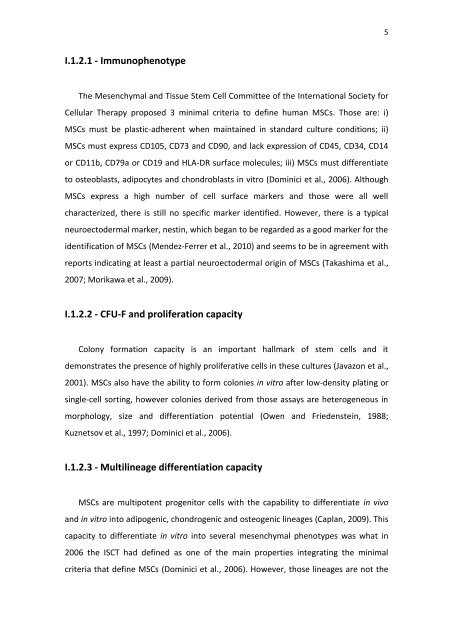DEPARTAMENTO DE CIÊNCIAS DA VIDA ... - Estudo Geral
DEPARTAMENTO DE CIÊNCIAS DA VIDA ... - Estudo Geral
DEPARTAMENTO DE CIÊNCIAS DA VIDA ... - Estudo Geral
You also want an ePaper? Increase the reach of your titles
YUMPU automatically turns print PDFs into web optimized ePapers that Google loves.
5<br />
I.1.2.1 - Immunophenotype<br />
The Mesenchymal and Tissue Stem Cell Committee of the International Society for<br />
Cellular Therapy proposed 3 minimal criteria to define human MSCs. Those are: i)<br />
MSCs must be plastic-adherent when maintained in standard culture conditions; ii)<br />
MSCs must express CD105, CD73 and CD90, and lack expression of CD45, CD34, CD14<br />
or CD11b, CD79a or CD19 and HLA-DR surface molecules; iii) MSCs must differentiate<br />
to osteoblasts, adipocytes and chondroblasts in vitro (Dominici et al., 2006). Although<br />
MSCs express a high number of cell surface markers and those were all well<br />
characterized, there is still no specific marker identified. However, there is a typical<br />
neuroectodermal marker, nestin, which began to be regarded as a good marker for the<br />
identification of MSCs (Mendez-Ferrer et al., 2010) and seems to be in agreement with<br />
reports indicating at least a partial neuroectodermal origin of MSCs (Takashima et al.,<br />
2007; Morikawa et al., 2009).<br />
I.1.2.2 - CFU-F and proliferation capacity<br />
Colony formation capacity is an important hallmark of stem cells and it<br />
demonstrates the presence of highly proliferative cells in these cultures (Javazon et al.,<br />
2001). MSCs also have the ability to form colonies in vitro after low-density plating or<br />
single-cell sorting, however colonies derived from those assays are heterogeneous in<br />
morphology, size and differentiation potential (Owen and Friedenstein, 1988;<br />
Kuznetsov et al., 1997; Dominici et al., 2006).<br />
I.1.2.3 - Multilineage differentiation capacity<br />
MSCs are multipotent progenitor cells with the capability to differentiate in vivo<br />
and in vitro into adipogenic, chondrogenic and osteogenic lineages (Caplan, 2009). This<br />
capacity to differentiate in vitro into several mesenchymal phenotypes was what in<br />
2006 the ISCT had defined as one of the main properties integrating the minimal<br />
criteria that define MSCs (Dominici et al., 2006). However, those lineages are not the
















